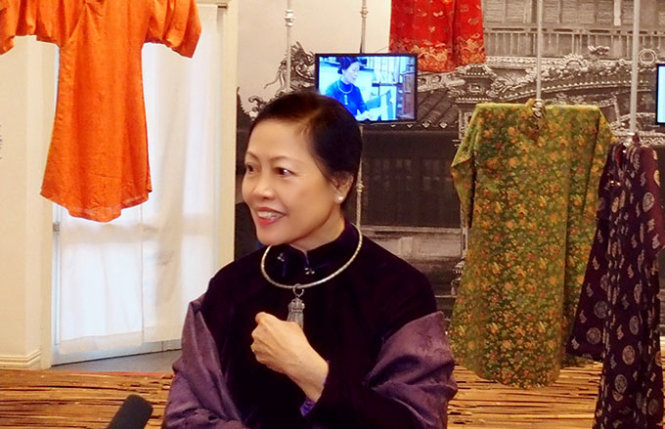A seasoned Vietnamese researcher and a noted designer have spent decades collecting, preserving, and promoting “ao dai” (traditional Vietnamese long gown).
>> An audio version of the story is available here
Prof. Thai Kim Lan, a revered researcher on German culture, has had her “ao dai” gowns displayed at an installation art exhibit in Hanoi since January 16.
The event, to close on Friday, is taking place at the Goethe Institut Hanoi, at 56-58 Nguyen Thai Hoc Street, Ba Dinh District, to accentuate the charms and historical values of the costumes which are part of an assortment of “ao dai” by Prof. Lan.
This assemblage has been preserved in Germany for 35 years, she said.
Born in Hue, Lan earned her PhD in philosophy at Ludwig-Maximilians-Universität, a university located in the heart of Munich, in 1976 and taught there until 2007 as a lecturer in comparative philosophy.
She told Tuoi Tre (Youth) newspaper that part of the “ao dai” donned by royal members during the Nguyen Dynasty (1802-1945) – Vietnam’s last monarchy – are her family heirlooms.
“Before I went to Germany for my studies in 1965, ‘ao dai’ was southern Vietnamese women’s most common costume. Even peddlers wore them while moving from place to place. However, when I first returned to Vietnam in 1977, I realized to my disappointment that the local streets were empty of the traditional gowns then,” Prof. Lan said.
Concerned her family’s treasured “ao dai” might get forsaken and damaged over the course of time, Lan insisted her mother send them over to Germany, where they have been preserved since.
Her collection also features those she collected herself during the 1980s.
“I was surprised at the profuse interest in the displayed ‘ao dai’ expressed by young people in Hanoi. The exhibition is only one part of a larger project. My partners and I are planning to hold talks on the costume in Hanoi, Hue City, and Ho Chi Minh City,” she added.
Lan also suggested her contemporaries write about the development of the gown throughout different periods.
“Vietnamese ‘ao dai’ are as unique as the country’s cuisine and need insiders’ experiences. I’m currently in quest of such experiences,” she noted.
The designer behind ‘ao dai’ museum

Two old-style "ao dai," typically donned by elderly Vietnamese women in the southern region, are seen at Sy Hoang's "ao dai" museum. Photo: Vietnamplus
Noted Vietnamese designer Sy Hoang has spent years collecting “ao dai.”
His long-nurtured dream was realized as his museum, which is dedicated to showcasing only “ao dai” through various periods as well as their making process, opened in District 9, Ho Chi Minh City, in January last year.
Hoang’s “ao dai” museum is located at 206/19/30 Long Thuan, Long Phuoc Ward.
Sitting in his 20,000m² garden house, which boasts rustic southern landscapes and age-old wood architecture, the museum showcases more than 60 “ao dai” owned by the Nguyen kings and royal families, female military leaders, diplomats, artists, and actresses.
Stories about these “ao dai” and their owners are also provided.
Also on view are renovated “Le Mur” and Le Pho “ao dai” in the 1930s, further renovated large-collar and hippy “ao dai” in the 1950s and 1960s, and those created by celebrated designer Minh Hanh in the 1990s.

Three old-style "ao dai" are pictured at Vietnamese designer Sy Hoang's "ao dai" museum. Photo: Vietnamplus
Hoang’s museum also hosts exhibitions of works in music, literature, cinema and art, which are inspired by the traditional costume.
“My passion for ‘ao dai’ budded by chance in 1989. Since then, I have made efforts to showcase the attire in over 20 countries. I’ve also visited several museums around the world, among which the kimono museum in Japan impressed me the most. The visit to such museums cemented my resolve to build my “ao dai” museum,” designer Sy Hoang said.
Hoang added he had dreamt of building an “ao dai” museum since his college days.
During that time, he would frequent several local museums to do extensive research on the traditional gown.

The gorgoeous "ao dai" on display at Vietnamese designer Sy Hoang's museum, which is dedicated to showcasing only the costumes. Photo: Vietnamplus
“The ‘ao dai’ has both esthetic and ethical values, as the wearer automatically adjusts her words and behaviors, while the opposite person can’t bear resentment or ill will against the wearer,” Hoang noted.
Hoang is known as one of the country’s salient “ao dai” designers.
He has designed sets of historical “ao dai” for major “cai luong” (reformed theater) plays.
The designer is also a successful businessman and art lecturer.
Like us on Facebook or follow us on Twitter to get the latest news about Vietnam!




















































